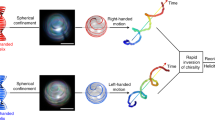Abstract
We analyse the helical motion of organisms, concentrating on the means by which organisms change the direction in space of the axis of the helical trajectory, which is the net direction of motion. We demonstrate that the direction of the axis is determined largely by the direction of the organism's rotational velocity. Changes in direction of the rotational velocity, with respect to the organism's body, change the direction in space of the axis of the helical trajectory. Conversely, changes in direction of the translational velocity, with respect to the body of the organism, have little effect on the direction in space of the axis of the trajectory. Because the axis of helical motion is the net direction of motion, it is likely that organisms that move in helices change direction by pointing their rotational velocity, not their translational velocity, in a new direction.
Similar content being viewed by others
Literature
Beatty, M. F. 1986.Principles of Engineering Mechanics. Vol. 1.Kinematics—The Geometry of Motion, 396 pp. New York, NY: Plenum Press.
Brokaw, C. J. 1958. Chemotaxis of bracken spermatozoids. Ph. D. thesis. Cambridge University, Cambridge, U.K.
Brokaw, C. J. 1974. Calcium and flagellar response during the chemotaxis of bracken spermatozoids.J. cell. Physiol. 83, 151–158.
Crenshaw, H. C. 1989. Kinematics of helical motion of microorganisms capable of motion with four degrees of freedom.Biophys. J. 56, 1029–1035. (Note correction inBiophys. J.,57, 1109.)
Crenshaw, H. C. 1990. Helical orientation: A novel mechanism for the orientation of microorganisms.Lect. Notes Biomath. 89, 361–386.
Crenshaw, H. C. 1993a. Orientation by helical motion—I. Kinematics of the helical motion of organisms with up to six degrees of freedom.Bull. math. Biol. 55, 197–212.
Crenshaw, H. C. 1993b. Orientation by helical motion—III Microorganisms can orient to stimuli by changing the direction of their rotational velocity.Bull. math. Biol. 55, 231–255.
Foster, K. W. and R. D. Smyth. 1980. Light antennas in phototactic algae.Microbiol. Rev. 44, 572–630.
Gillett, P. 1984.Calculus and Analytic Geometry, 2nd edn, 915 pp. Lexington, MA: D. C. Heath.
Jennings, H. S. 1901. On the significance of the spiral swimming of organisms.Am. Nat. 35, 369–378.
Jennings, H. S. 1904.Contributions to the study of the behavior of lower organisms. Carnegie Institute of Washington, Publication No. 16.
Kamiya, R. and G. B. Witman. 1984. Submicromolar levels of calcium control the balance of beating between the two flagella in demembranated models ofChlamydomonas.J. Cell Biol. 98, 97–107.
Machemer, H. 1989. Cellular behaviour modulated by ions: Electrophysiological implications.J. Protozool. 36, 463–487.
Miller, R. L. 1985. Sperm chemo-orientation in the metazoa. InBiology of Fertilization. II. Biology of the Sperm, C. B. Metz and A. Monroy (Eds), pp. 276–337. New York, NY: Academic Press.
Naitoh, Y. and K. Sugino. 1984. Ciliary movement and its control inParamecium.J. Protozool. 31, 31–40.
Párducz, B. 1964. Swimming and its ciliary mechanism in,Ophryoglena sp.Acta Protozool. 2, 367–374.
Purcell, E. M. 1977. Life at low Reynolds number.Am. J. Phys. 45, 3–11.
Rüffer, U. and W. Nultsch. 1985. High-speed cinematographic analysis of the movement ofChlamydomonas.Cell Motil. 5, 251–263.
Sugino, K. and Y. Naitoh. 1988. Estimation of ciliary activity inParamecium from its swimming path.Seitai Nō Kagaku.39(5), 485–490.
Symon, K. R. 1971.Mechanics 3rd edn, 639 pp. Reading, MA: Addison-Wesley.
Author information
Authors and Affiliations
Rights and permissions
About this article
Cite this article
Crenshaw, H.C., Edelstein-Keshet, L. Orientation by helical motion—II. Changing the direction of the axis of motion. Bltn Mathcal Biology 55, 213–230 (1993). https://doi.org/10.1007/BF02460303
Received:
Revised:
Issue Date:
DOI: https://doi.org/10.1007/BF02460303




